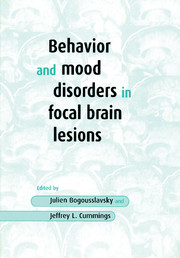Book contents
- Frontmatter
- Dedication
- Contents
- List of contributors
- Preface
- Acknowledgments
- 1 Emotional consequences of focal brain lesions: an overview
- 2 The evaluation of mood and behavior in patients with focal brain lesions
- 3 Methodological issues in studying secondary mood disorders
- 4 Emotional behavior in acute brain lesions
- 5 Depression and lesion location in stroke
- 6 Mood and behavior in disorders of the basal ganglia
- 7 Mania and manic-like disorders
- 8 Behavioral and emotional changes after focal frontal lobe damage
- 9 Disorders of motivation
- 10 Thalamic behavioral syndromes
- 11 Obsessive-compulsive disorders in association with focal brain lesions
- 12 Emotional dysprosody and similar dysfunctions
- 13 Temporal lobe behavioral syndromes
- 14 Neural correlates of violent behavior
- 15 Focal lesions and psychosis
- 16 Alterations in sexual behavior following focal brain injury
- 17 Anosognosia
- 18 Acute confusional states and delirium
- Index
7 - Mania and manic-like disorders
Published online by Cambridge University Press: 05 August 2016
- Frontmatter
- Dedication
- Contents
- List of contributors
- Preface
- Acknowledgments
- 1 Emotional consequences of focal brain lesions: an overview
- 2 The evaluation of mood and behavior in patients with focal brain lesions
- 3 Methodological issues in studying secondary mood disorders
- 4 Emotional behavior in acute brain lesions
- 5 Depression and lesion location in stroke
- 6 Mood and behavior in disorders of the basal ganglia
- 7 Mania and manic-like disorders
- 8 Behavioral and emotional changes after focal frontal lobe damage
- 9 Disorders of motivation
- 10 Thalamic behavioral syndromes
- 11 Obsessive-compulsive disorders in association with focal brain lesions
- 12 Emotional dysprosody and similar dysfunctions
- 13 Temporal lobe behavioral syndromes
- 14 Neural correlates of violent behavior
- 15 Focal lesions and psychosis
- 16 Alterations in sexual behavior following focal brain injury
- 17 Anosognosia
- 18 Acute confusional states and delirium
- Index
Summary
Introduction
In 1888, Leonore Welt, a German psychiatrist, suggested for the first time an association between focal cerebral lesions and manic-like behaviors. She described the case of a patient with a change in character, expressed by restlessness, euphoria, overtalkativeness, and a lowering of ethical and moral standards, after bilateral damage to the orbitofrontal cortex. In the same year, Jastrowitz (1888) reported elated behavior, pressured speech, and obscene language in a series of patients with frontal lobe tumors.
Surgical brain procedures were also reported to produce manic behaviors. Reitman (1946) reported hyperactivity, euphoria, and disinhibited behaviors in a group of patients treated with orbitofrontal leukotomy, whereas in a comprehensive study of cognitive and emotional complications of frontal surgery, Rylander (1939) described euphoria, hyperactivity, and hypersexuality as frequent behavioral sequelae.
On the other hand, manic disorders after focal brain lesions have been reported only recently. Jampala and Abrams (1983) reported two patients who developed manic behaviors after left and right fronto-temporal lesions respectively, and Cummings and Mendez (1984) reported two patients with manic behaviors after right thalamic lesions. Milder cases of disinhibited behavior have been recently reported. Gorman and Cummings (1992) reported hypersexuality in two patients with septal injury, and Regard and Landis (1997) described a nondisabling form of hyperphagia, with a specific preference for fine food (which they termed the ‘gourmand syndrome’), with most patients having right anterior lesions. Taken together, the above descriptions suggest that either partial or full-blown disinhibition syndromes may result from focal brain lesions.
This chapter examines methodological issues, clinical characteristics, and anatomical correlates of manic behaviors after focal brain damage. Based on the above, a mechanism for this interesting behavioral phenomenon is proposed.
Methodological issues
In a recent publication, Starkstein and Robinson (1997) discussed important methodological considerations concerning the diagnosis of manic-like disorders in patients with brain lesions, and we will briefly summarize the most relevant points. Manic-like behaviors have been ascribed different terms within neurological and psychiatric fields. Thus, the neurological literature includes terms such as the ‘frontal lobe syndrome,’ ‘pseudopsychopathic syndrome,’ ‘disinhibition syndrome,’ and ‘acquired sociopathy.’ One important limitation is that none of these terms has been syndromically defined, and whether they refer to independent or overlapping syndromes has not been empirically determined.
- Type
- Chapter
- Information
- Behavior and Mood Disorders in Focal Brain Lesions , pp. 202 - 216Publisher: Cambridge University PressPrint publication year: 2000
- 3
- Cited by



